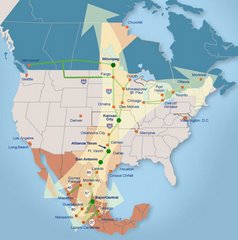It takes us (on average) 31% longer to get to our destination in Austin during peak hours.
To compare, LA (the worst congested) takes 77% longer.
AMERICAN-STATESMAN STAFF
Wednesday, September 19, 2007
That Greater Austin is "the most congested medium-sized city in America" has become something of a mantra among local transportation officials, a handy fact used to justify or oppose toll roads, promote green measures or, this week, attack a proposed bus fare increase.
The Texas Transportation Institute, in its biannual Urban Mobility Report released today, once again puts the Austin metro area in that dubious position, giving it a congestion index of 1.31. That figure, which means a rush-hour trip takes 31 percent more time than the same journey at off-peak hours, puts Austin and its suburbs atop 30 metro areas designated as medium-sized.
However, the criteria used for that grouping lists the Austin-area population as 855,000, just less than 60 percent of the 1.45 million people that U.S. Census bureau says lived in the Austin metropolitan area in 2005, the year studied in the report. Most other similarly sized American cities in the report are credited with 70 percent to 80 percent of their total metro population.
The reason for the discrepancy is that the institute bases its calculations on data from "urbanized areas," rather than using entire metropolitan areas. If a satellite town, such as Georgetown or San Marcos, has slivers of rural areas separating them from the central city and close-in suburbs, then they fall out of the urbanized area.
The relatively stingy population estimate has the effect of putting Austin below the 1 million population threshold for a "large" city (thus the "medium-sized city" designation) and of driving up Austin's congestion index.
"I'm not sure how much lower the number would come down"if more of the Austin metro area was included in the calculations, said study co-author Tim Lomax, a research engineer at the Texas A&M University-based institute.
Austin traffic, according to the report, has worsened steadily through the years. In 1982, Austin's congestion index was 1.07, causing about a minute and a half of delay on what would be a 20-minute trip outside of rush hour. By 1992, that number had increased only slightly to 1.12.
But in 2000, after the high-tech boom of the late 1990s, the index had reached 1.24 in Austin, five extra minutes for that 20-minute trip. The estimated delay on that 20-minute jaunt now would be just over six minutes.
And in those 23 years, according to the report, the percentage of the Austin-area road system experiencing congestion during rush hours has grown from 21 percent to 55 percent. The hours of such congestion, it says, have grown from three hours in 1982 to 7.2 hours now.
Austin's congestion, by the calculations of the report, is the 15th worst among the 85 cities studied (which includes the largest metro areas such as New York and Los Angeles). Among Texas cities, it's worse than San Antonio's 1.23 index and not much better than Dallas-Fort Worth and Houston, which have travel time indexes of 1.35 and 1.36, respectively.
And because the data in the 2007 study dates to 2005, that means the 61.5 miles of four- and six-lane tollways that came online around Central Texas in the past year do not figure into the ratings. Austin's index could improve when the next report comes out in 2009.
"Something to look forward to," Lomax said. "The key would be how much traffic is on those new lane-miles."
Traffic has been heavier than expected on all four tollways added, but is still light on the longest of those roads, Texas 130.
The institute has been studying urban traffic and issuing the mobility report since 1982. Lomax and his associate, David Schrank, do not literally time people's commutes, but use traffic counts along with specific highway and public transit data.
Congestion, Lomax and Schrank say in the report, is a problem in all American cities and is getting worse.
"The solution to this problem is really to consider all the solutions," the report says. "One lesson from more than 20 years of mobility studies is that congestion relief is not just a matter of highway and transit agencies building big projects."
The authors recommend a combination of such expensive construction and additional strategies — telecommuting, flexible working hours, clearing accident scenes faster, strategic construction to eliminate "choke points" in the highway system — to create "a balanced and diversified approach to reduce congestion."
However, the authors say, "realistic expectations are also part of the solution. Large urban areas will be congested. Some locations near key activity centers in smaller urban areas will be congested. But congestion does not have to be an all-day event."
bwear@statesman.com, 445-3698
















No comments:
Post a Comment